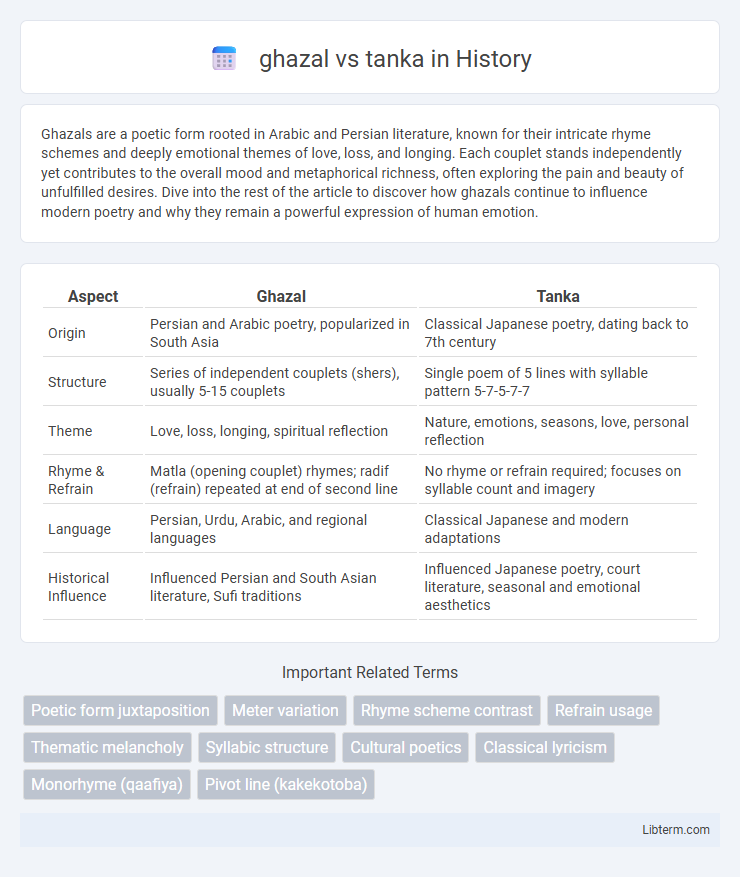Ghazals are a poetic form rooted in Arabic and Persian literature, known for their intricate rhyme schemes and deeply emotional themes of love, loss, and longing. Each couplet stands independently yet contributes to the overall mood and metaphorical richness, often exploring the pain and beauty of unfulfilled desires. Dive into the rest of the article to discover how ghazals continue to influence modern poetry and why they remain a powerful expression of human emotion.
Table of Comparison
| Aspect | Ghazal | Tanka |
|---|---|---|
| Origin | Persian and Arabic poetry, popularized in South Asia | Classical Japanese poetry, dating back to 7th century |
| Structure | Series of independent couplets (shers), usually 5-15 couplets | Single poem of 5 lines with syllable pattern 5-7-5-7-7 |
| Theme | Love, loss, longing, spiritual reflection | Nature, emotions, seasons, love, personal reflection |
| Rhyme & Refrain | Matla (opening couplet) rhymes; radif (refrain) repeated at end of second line | No rhyme or refrain required; focuses on syllable count and imagery |
| Language | Persian, Urdu, Arabic, and regional languages | Classical Japanese and modern adaptations |
| Historical Influence | Influenced Persian and South Asian literature, Sufi traditions | Influenced Japanese poetry, court literature, seasonal and emotional aesthetics |
Introduction to Ghazal and Tanka
Ghazal is a poetic form originating from Arabic and Persian literature, consisting of rhyming couplets and a refrain, often expressing themes of love, loss, and mysticism. Tanka, a classic Japanese poetry style, is composed of five lines with a 5-7-5-7-7 syllabic structure, traditionally exploring nature, emotions, and seasons. Both forms emphasize emotional expression but differ significantly in cultural context, structure, and thematic focus.
Historical Origins and Evolution
Ghazal originated in 7th-century Arabic poetry and evolved through Persian, Urdu, and South Asian literary traditions, emphasizing themes of love and metaphysical reflection within a strict rhyming scheme and refrain. Tanka, with roots tracing back to 5th-century Japan, developed as an early form of waka poetry and features a concise 31-syllable structure (5-7-5-7-7) often exploring nature and emotions. Both forms have undergone cultural adaptations, with ghazal incorporating musical and spiritual elements, while tanka remained a foundational poetic expression influencing later Japanese haiku.
Structural Differences
Ghazal consists of rhyming couplets and a refrain, typically written in Urdu or Persian, with each couplet standing independently in theme. Tanka is a Japanese poetic form composed of five lines with a syllabic pattern of 5-7-5-7-7, creating a single cohesive thought or image. The ghazal's repetitive rhyme scheme contrasts with the tanka's syllabic structure and unified narrative.
Thematic Focus and Subjects
Ghazals typically explore themes of love, loss, and metaphysical questions, often emphasizing the pain and beauty of unrequited affection or spiritual longing. Tanka poems concentrate on nature, seasons, and human emotions, capturing fleeting moments and personal reflections with a concise yet vivid imagery. Both forms express deep emotional resonance but differ in cultural context and thematic emphasis, with ghazals rooted in Persian and Urdu traditions, and tankas in Japanese aesthetics.
Language and Imagery
Ghazal, rooted in Persian and Urdu literature, showcases intricate rhyming patterns and repetition, often evoking themes of love and loss through rich, metaphorical language and vivid imagery. Tanka, a classical Japanese poetry form, employs concise, 31-syllable structure emphasizing nature and emotional reflection, using subtle, sensory imagery to convey depth in brevity. Both forms harness linguistic nuances to evoke powerful emotional landscapes, but ghazal emphasizes ornate expressions, while tanka favors minimalist, delicate imagery.
Form and Meter Comparison
Ghazal is composed of rhyming couplets, each with a fixed meter, typically featuring a refrain and maintaining a consistent radif and qaafiyaa pattern, often in 10-15 syllables per line. Tanka follows a 5-7-5-7-7 syllabic pattern with a total of 31 syllables, emphasizing a concise and syllabically strict form without rhyme. The ghazal's meter is intricately structured around repeated phonetic and thematic elements, while the tanka relies on brevity and syllabic precision to convey imagery.
Role of Repetition and Rhyme
Ghazals rely heavily on repetition, particularly through the recurring matla (opening couplet) and the radif (repeated phrase), creating a melodic and emotional resonance throughout the poem. Tanka employs a fixed syllable pattern (5-7-5-7-7) without rhyme or repeated phrases, focusing instead on concise imagery and emotional expression. The repetitive rhyme and refrain in ghazals emphasize thematic unity, while tanka's absence of repetition fosters a more subtle and direct poetic impact.
Cultural Significance
Ghazal holds deep cultural significance in South Asian literature, symbolizing themes of love, loss, and mysticism often linked to Persian and Urdu poetic traditions. Tanka, rooted in Japanese culture, encapsulates nature, seasons, and emotions within a concise 31-syllable structure, reflecting the aesthetics of simplicity and subtlety. Both forms serve as vital expressions of their respective cultural identities, preserving historical values through poetic artistry.
Contemporary Adaptations
Contemporary adaptations of the ghazal emphasize thematic experimentation and fusion with modern musical genres, blending traditional Persian poetic structure with global cultural influences. In contrast, the tanka has evolved through minimalist and nature-inspired themes, often merging with visual arts and digital media to maintain relevance in contemporary Japanese literature. Both forms reflect dynamic reinterpretations that honor their classical roots while engaging modern audiences through innovative artistic expressions.
Choosing Between Ghazal and Tanka
Choosing between Ghazal and Tanka depends on thematic focus and structural preference. Ghazals, rooted in Persian and Urdu literature, consist of rhyming couplets with a refrain and explore themes of love, loss, and mysticism. Tanka, a classical Japanese short poem format with a 5-7-5-7-7 syllabic structure, is ideal for capturing moments of nature, emotions, and seasonal imagery in concise, evocative language.
ghazal Infographic

 libterm.com
libterm.com